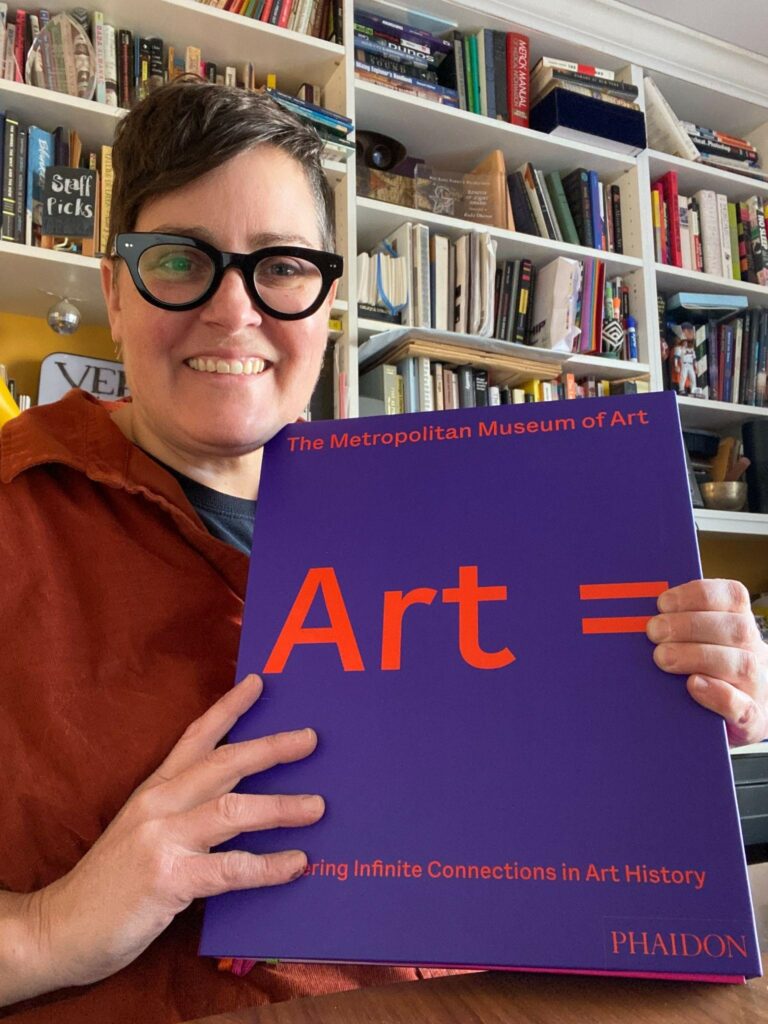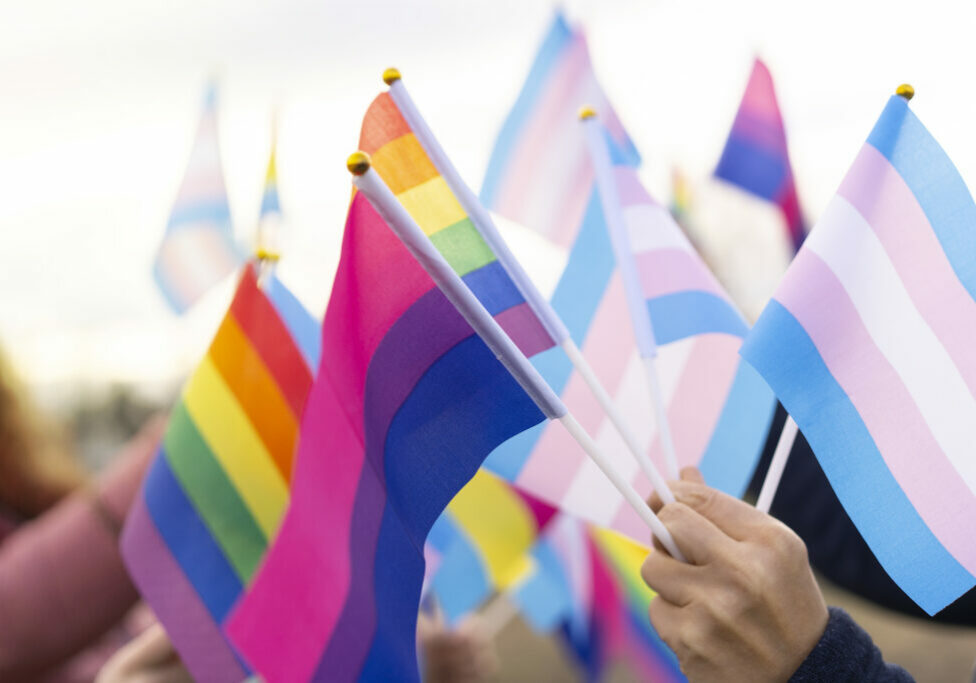By Kate Okeson with Amy Moran, Ph.D.
Several years ago, I started teaching an art history course in my high school. As a survey of all of art history, the texts and course syllabi recommended a few weeks in the middle of the year-long course be dedicated to “Art Outside the Western Tradition.”
I was shocked.
In my own studio art training, there were no requirements that limited the scope of human artistic expression to those from a sliver of the planet. As a contemporary art maker, my studies were largely about the interconnected nature of human creativity: our individual voices and lived experiences that together weave an incredibly complex history (and possibility for a vibrant and interconnected future).
As I was planning and writing lessons in line with the recommended curriculum, my inner voice began to get awfully loud. I questioned, “What was lost by following this narrow presentation of the human history of artmaking?” The exclusive nature of that particular survey of art history failed to present a contextualized narrative that reflected artmaking by humans around the globe. The message was that if art wasn’t from the European, European-American, and colonized North American canons, then those works weren’t central in the scope of art history.
I’m not saying that the works weren’t valuable to study, but the art historical nomenclature of “outside the European Tradition” gives undue influence to the works by a largely male, European, European-American, and (non-indigenous/settler) North American artists without context of the many histories that intersect around one object at one point in time.
The artwork in that original survey of art history was good, but the storytelling was flawed. And this is where it’s important to understand the intractable role of texts (including anything we construe as a text in the classroom) and access to these texts for not only students, but for teachers for educational planning and preparation.
Mirrors, windows and sliding glass doors
Rudine Sims Bishop, professor emeritus at Ohio State University, gave the education world a lighthouse with her concept of “mirrors, windows, and sliding glass doors.” Many of us are familiar with this idea that books connect us to images of ourselves (mirrors) and also can provide a view into other worlds (windows). Bishop extends the power of texts to also become sliding glass doors where we can enter this other world as well. She states, “that’s the reason that diversity needs to go both ways. I mean it’s not just children who have been underrepresented and marginalized who need these books.” Here, Bishop reminds us that there is a whole world outside any limited syllabus or cluster of preselected texts that we can explore.
How might educators use a critical lens to notice what’s missing? An interview with Bishop from 2005 provides some insight to the role of diverse books and their connection to what we teach. She said, “So, I look at the end to see the bibliography. What were the books that they used? And so often there are no books from underrepresented groups that are a part of that project.” That is not because such books don’t exist. Rather, a bibliography is a collection of authors’ explicit choices around what to include and what to exclude. Similarly, as we plan our units, we have the choice to survey district-provided resources for what is being included and what is being excluded—and to fill in the gaps with texts, resources, and student-centered activities where vital perspectives and experiences had been missing.
Many professional organizations have position statements on the necessity of diverse reading and text at the core of improving our connections to and outcomes for all of our youth. While we primarily focus on these outcomes related to LGBTQIA+ youth, we extend this to all content areas and all underrepresented communities. Because that is who we teach every day: many different young people who belong to all sorts of communities and hold many identities. Taking action and finding these diverse texts are the next steps.
We can do this in lots of ways:
- In PLCs with colleagues.
- As part of a PDP that we work on over the course of a school year.
- In our local independent bookstores.
- Online through compilations, such as book lists in the monthly “Rainbow Connection” QR code resource link.
And sometimes it’s not just the new book, but it’s a book that is organized in new ways, which is helpful in mitigating the impact of old, limiting narratives.
As an example, the Metropolitan Museum of Art published a new book called Art =, a catalog of about 800 works in their collection*, which are neither in date order nor use categories that center the Western canon. Instead, the book presents the works connected by materials they are made of, or central themes, or a named style regardless of where or when in the world they were created. So unlike the original art history survey course that I was supposed to teach those years ago, this book doesn’t organize art as 90% about ‘us’ and 10% about ‘them.’ Instead, it organizes the works around the creative objects and universal ideas that humans use to make art everywhere (and across time). For me and my fellow art nerds, this is a welcome invitation to make our own connections about the works and perhaps see a little more of ourselves and more of others who are not like us at all.
*This book and institution are not without critique! A long history of how works came to be in major collections like the Met’s is a worthwhile exploration, but not the central topic herein.

From limitation and frustration to INSPIRATION and CONNECTION
Kate’s analysis of ideas presented in her content area—and the limiting or connecting ways that those ideas are presented—is applicable to all of us in our content areas as well. Because the New Jersey LGBTQIA+ curricular mandate articulates expectations for queer inclusion across all content areas from grades 5 or 6 through 12, now is the time to look at our units and notice where cisgender, heteronormative perspectives and experiences are being privileged and where those of LGBTQIA+ people should be added.
For example:
- Biology: In units on heredity and human development, are intersex people mentioned in positive and affirming ways? Are phrases like “disorders in sexual development” modified to become “variations in sexual development”?
- Math and statistics: When using data sets to numerically describe phenomena, is positive and affirming data about LGBTQIA+ people included?
- English/literature: Are works by queer people included, and is their queerness discussed as a contributing and vital part of their unique perspectives as authors?
- History/social studies: What was life like for the LGBTQIA+ people who existed at that period of time? Do your units include the perspectives of queer people—and if they don’t, do you bring that up with students?
As we know, omissions in textbooks from any content area don’t just happen because those people or experiences or truths didn’t exist. Rather, they’re a collection of purposeful choices by authors—including school district curriculum writers—that marginalize and exclude. This omission has been frustrating (and even haunting) for LGBTQIA+ people in classrooms, and any examination of syllabi, text sets, or project options for the purpose of identifying where queer representation was omitted is welcome! But that’s just the first step. Consider these:
- Survey: Look at the unit you’re teaching right now.
2. Identify: Where are LGBTQIA+ people and their experiences mentioned explicitly in this unit?
3. Analyze:
- If they’re omitted, ask, “Why?”
- If they’re included, ask, “Are these representations positive and affirming?”
4. Add: If queer people and their experiences are completely missing, search for texts and discussion items to include that are positive and affirming OR that explain the omission with:
- Compassion for how it must feel for those being omitted.
- Accountability for those who did the omitting.
5. Collaborate: Check with other stakeholders to ensure that your inclusive work will have the intended impact of being positive and affirming. Connect with folks like:
- Your school’s GSA adviser.
- Student leaders in the GSA (through their adviser).
- Ally colleagues in your content-area PLCs.
- Ally colleagues in your grade level.
- Your county-level NJEA Sexual Orientation and Gender Identity Committee (SOGI) representative.
- All colleagues who have been doing the vital work of noticing gaps in curricular representation for all students—gaps of any kind—and filling them with positive and affirming reflections and experiences of people from all walks of life.
Kate is totally inspired by her new book Art = for the ways that it categorizes kinds of art and ways those works were made (rather than by people who include themselves and others like them but exclude everyone else). But so too can each of us be inspired to find new ways of looking at our own curricular resources for their potential to connect the experiences of LGBTQIA+ people and straight/cisgender people with and within our respective content areas.
Would you like to share your journey with an inspirational text or syllabus that was ready for your special touch? Connect with us at RainbowConnectionNJEA@gmail.com.
